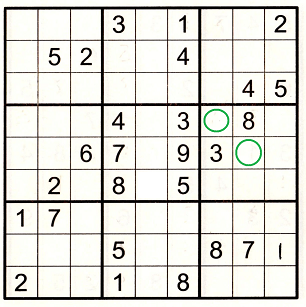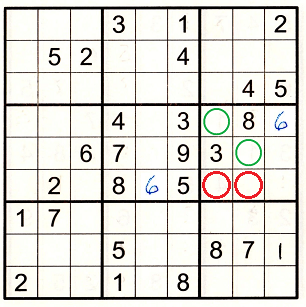Pattern: Diagonal Pattern
<< Return to patterns page
Next pattern: right-angle pattern >>
Introduction
The diagonal pattern can be found with only two numbers in a box. This pattern can help locate twins. If twins are found it can help find other numbers.
There can be more than two numbers in a box that has the diagonal pattern but only two numbers are needed for the diagonal pattern to exist.
Details
When two numbers are kitty-corner from each other in a box, or in other words the corners of the numbered cells are touching, the diagonal pattern exists. See figure 1 below.

Figure 1
Look at box 6 in figure 1. The 3 and the 8 form a diagonal pattern. This pattern allows us to look for twins. If twins are found they would be in the green circled cells.
Finding Twins
When this pattern is found look at the row and the column in the box that don't contain either of the two numbers (in this case row 6 and column 9). If you can find two numbers that are in both the row and the column and they aren't already in the box then you have found twins. Figure 1 has a 2 and a 5 in both row 6 and column 9 and therefore the green circled cells are 25 twins. Take a look at figure 1 and convince yourself that this is so.
The twins may or may not be solvable. If they can be solved the diagonal pattern becomes a corner pattern. There is still a corner pattern (a hidden one) if the twins can't be solved because no other numbers can fit in those two cells.
In this example the 25 twins are there but we can't solve them yet. But we can still find numbers. Read on.
Finding other numbers after twins
Now that we know the corner pattern is there we can look for other numbers. Notice the 1 in column 9. Because of the hidden corner pattern in box 6 we now know that the 1 is constrained to row 6 in box 6 (the cells with red circles). See figure 2 below.

Figure 2
Because of this we know that r6c5 must be a 6 and we also know we can now place the 6 in box 6. See if you understand why.
Extra Credit!
As an additional exercise see if you know where the 4 now goes in box 6.
Summary
As you can see the diagonal pattern can be helpful in a couple of ways. First it helps find twins. Second, whether those twins can be solved or not, it helps find other numbers.
Video about the diagonal pattern
This video talks about the diagonal pattern and shows examples of it.
Skill Levels
You can find the diagonal pattern in puzzles of any skill level. Harder levels will have fewer numbers so it will be harder to find the pattern. But as the puzzle progreses more numbers can yield more twins via the diagonal pattern.
Next pattern: right-angle pattern >>
<< Return to patterns page
If Sudoku Primer and the YouTube channel have helped you, consider donating a little

Thanks in advance for your support!
More About Sudoku
Sudoku - the puzzle that addicts
